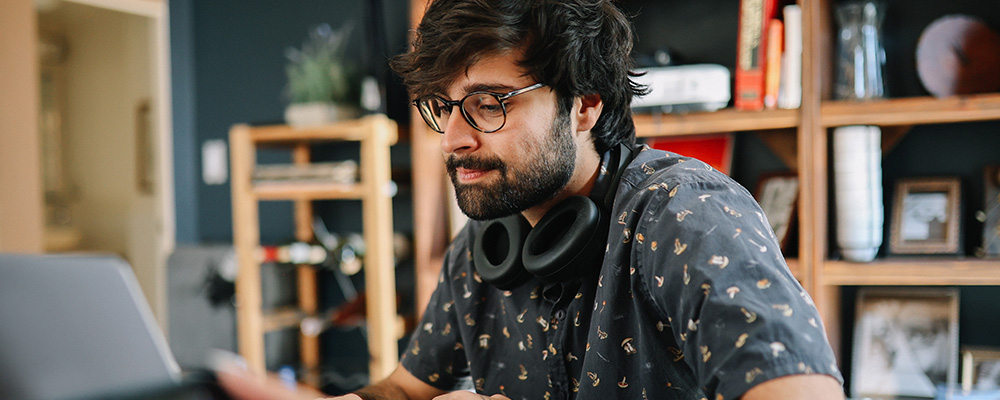Web designers are in demand more than ever before. More than 177,300 websites are created on the internet every day1. That’s around 123 websites every minute! Join the growing number of tech-savvy creatives who are website-building user experience machines. Here’s how to become a web designer.
How to become a web designer
Becoming a web designer requires a combination of education, creativity and experience, as well as sharp web page design skills. Here are some tips for getting started.
Step 1: Learn the basics of web design
While there are no strict web design course prerequisites, getting a degree, like Charles Sturt’s Bachelor of Information Technology2, will kickstart your journey. Gain designer skills, website design expertise, programming language and essential digital skills.
Step 2: Get practical experience
When you study with us, you’ll flex your web designer skills in the real world with professional placements. Get essential web designer skills like HTML, CSS, JavaScript, and data analytics.
Step 3: Create a strong portfolio
An impressive portfolio is key for web design pros to show what they can do – build websites that get results. Your portfolio is a great way to demonstrate web design capability, technical skills and user experience design.
Start small with personal projects, lend a hand to non-profits or take on freelance web design gigs to beef up your portfolio and get hands-on experience.
Step 4: Start growing your network
Keep updated with industry news, workshops, social media and online communities. Research and connect with UX designers, graphic designers, visual designers and web design businesses.
Step 5: Search for job opportunities
Use a search engine to look for web designer jobs. Seek and Indeed are great places to start. Browsing designer job ads will help you prepare for essential job criteria when you’re ready to apply for your first web design job.
Step 6: Start your new career
One minute you’re learning web design and the next, you’re growing your skills and designing websites. You could work on building platforms, dabble in artificial intelligence, or improve the user experience (UX).

Why web design is important
The web is our go-to for info, things we need and things we want to buy. It can feel like everyone’s living online 24/7. That’s why having an engaging website matters.
- First impressions count: A killer design and effective website usability will hook people in, build trust, and keep them returning. Plus, it can set you apart, especially in a crowded marketplace.
- User experience (UX): UX is, well, everything. Navigating a site should be smooth sailing, with seamless navigation, intuitive layouts and interactive elements that keep people around and wanting more.
- Brand identity: Web design is one of the ways organisations can stand out. Clever design can make the brand come across loud and clear. Compelling visuals and cohesive design on a website shout: “This is us!”
- SEO-friendly design: And of course, every organisation wants to be at the top of the search pile. That’s where SEO-friendly design comes in. Web designers are masters of the SEO game, creating clean code and fast load times, so people can find a site easily.
- Conversion optimisation: Last but not least, you want people to actually do things on your site, right? That’s where conversion comes in. Your designs will nudge people to take action, whether it’s signing up, buying something or hitting that ‘subscribe’ button.
So, web design is the secret weapon in an organisation’s success. It’s how you get people excited, keep them coming back for more and make real connections with your audience.
What are the different types of web design?
Different types of web design serve different purposes. And choosing which way to go will depend on user and search engine needs.
- Responsive web design: This aims to make website presentation easier by displaying content effectively on different devices and in different forms. This is particularly important when you can’t guarantee that your audience will use a mobile, tablet or desktop to consume your content.
- Static web design: Sometimes less is more! This type of web design is ideal when you don’t need the data to change. Static websites are made in HTML, CSS and Java.
- Dynamic website design: Need your data to be dynamic? A dynamic website is the key! This involves layouts that accommodate real-time content updates, such as animations and interactivity.
Where do web designers work?
Where don’t they work?! A web design career can take you to many places. You could work:
- from the comfort of your home
- remotely from a tropical island
- a web design and development agency
- an office as an in-house web designer
- anywhere with a reliable internet connection.
The choice is yours!
What skills do web designers need?
If you want to become a web designer, here are some skills to add to your design toolkit:
- CSS: Cascading Style Sheets (CSS) is a style sheet language used to present and style code.
- HTML: While some website builders use drag-and-drop interfaces, it helps to be familiar with and understand HTML code.
- JavaScript: Known as JS, is a programming language and core web technology. This is used by 99 per cent of websites!
- Software design: You’ll need to conceptualise how software systems work before they are implemented or modified.
- UX: User experience is all about how people interact with a website. It includes functionality, ease of use and efficiency.

What soft skills are useful?
Beyond knowing the tech stuff, smashing it in the web design game also means having some serious soft skills in your toolkit.
- Adaptability: The web world changes faster than you can say “HTML.” Stay flexible, keep learning and be at the cutting-edge of industry trends.
- Attention to detail: Perfecting your designs means sweating the small stuff and making sure every little thing is right.
- Client management: Understand what they want, handle feedback like a pro and always keep the lines of communication open.
- Communication: Chatting with clients, understanding their needs and explaining your designs is key.
- Creativity: This one goes without saying. Web design is all about thinking outside the box and then dreaming up designs that speak to your audience.
- Problem-solving: You’ll hit roadblocks, sure. But with adaptable problem-solving skills, you’ll find your way around them.
- Time management: Learn to juggle tasks, manage your time like a boss and deliver top-notch work on time.
Become a web designer with Charles Sturt

So, now you know what a web designer is and what they do, you can kickstart your journey to success with our Bachelor of Information Technology.
Want more info about how to become a web designer? Just reach out. We’re happy to answer any questions and chat through your options.
FAQs
What degree is best for becoming a web designer?
If you want to become a web designer, a computer science, information technology or software degree will put you in good stead. You could choose from our online courses and study completely online or combine on-campus and online study. Our Bachelor of Information Technology will give you all the essential skills you need for career paths in web design.
What is the difference between a front-end and back-end developer?
Front-end developers specialise in the visual aspects of a website. These are the parts that the user sees and interacts with. In comparison, back-end developers focus on the structure, system, data and logic of a website.
What skills do web designers need?
To create engaging and user-friendly websites, web designers need creativity, an understanding of coding languages, technical ability, time management, user experience capability and a passion for building websites.

Guess what? You could score an offer to study the Bachelor of Information Technology based on your soft skills. Check out the Charles Sturt Advantage early offer program.
1Exploding Topics, 2024
2CRICOS: 012006F


You must be logged in to post a comment.